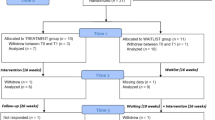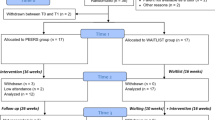Abstract
This study compared immediate and 4-month outcomes among adolescents with autism spectrum disorder randomly assigned to the PEERS curriculum (n = 10), a peer mediated PEERS curriculum (n = 12), or a delayed treatment control group (n = 12). Findings suggest a modest advantage in social skills knowledge and social functioning for participants in the peer-mediated PEERS curriculum relative to Traditional PEERS, and gains in social skills knowledge, social functioning, and reductions in loneliness were maintained in one or both treatment groups at a 4-month follow-up. Typically developing peer mentors (n = 16) showed improvements in social skills knowledge and marginal improvements in autism knowledge and loneliness. Future research with a larger sample and objective outcome measures is needed.

Similar content being viewed by others
Change history
19 March 2018
The original version of this article unfortunately contained a mistake.
Notes
A non-parametric Kruskal–Wallis test indicated a marginally significant effect of study group on R-UCLA changes scores from time 1 to time 2 [H (2) = 5.38, p = .07].
When the extreme outlier was included, there was not a significant increase in autism knowledge [t (15)= − 0.83, p = .42, d = 0.21]. This participant demonstrated a change score of − 10 on the AKQ; the next lowest change score was − 3. The clinicians reported that this teen arrived late to the final session and seemed to be rushing to complete the post assessments.
References
American Psychiatric Association. (2013). Diagnostic and statistical manual of mental disorders (5th edn.). Arlington, VA: American Psychiatric.
Bogardus, E. S. (1933). A social distance scale. Sociology & Social Research, 17, 265–271.
Camarena, P. M., & Sarigiani, P. A. (2009). Postsecondary educational aspirations of high-functioning adolescents with autism spectrum disorders and their parents. Focus on Autism and Other Developmental Disabilities, 24, 115–128. https://doi.org/10.1177/1088357609332675.
Centers for Disease Control and Prevention (CDC), U.S. Department of Health and Human Services. (2014). Prevalence of autism spectrum disorder among children aged 8 years—Autism and Developmental Disabilities Monitoring Network, 11 sites, United States, 2010. MMWR, 63(2), 1–22.
Chan, J. M., Lang, R., Rispoli, M., O’Reilly, M., Sigafoos, J., & Cole, H. (2009). Use of peer-mediated interventions in the treatment of autism spectrum disorders: A systematic review. Research in Autism Spectrum Disorders, 3(4), 876–889. https://doi.org/10.1016/j.rasd.2009.04.003.
Christensen, D. L., Bilder, D. A., Zahorodny, W., Pettygrove, S., Durking, M., Fitzgerald, R. T., … Yeargin-Allsopp, M. (2016). Prevalence and characteristics of autism spectrum disorder among 4-year-old children in the Autism and Developmental Disabilities Monitoring Network. Journal of Developmental and Behavioral Pediatrics, 37, 1–8. https://doi.org/10.1097/DBP.0000000000000235.
Constantino, J. N., & Gruber, C. P. (2012). Social Responsiveness Scale, Second Edition (SRS-2). Torrance, CA: Western Psychological Services.
Dingfelder, H. E., & Mandell, D. S. (2011). Bridging the research-to-practice gap in autism intervention: An application of diffusion of innovation theory. Journal of Autism and Developmental Disorders, 41, 597–609. https://doi.org/10.1007/s10803-010-1081-0.
Fortune, A. E., Pearlingi, B., & Rochelle, C. D. (1992). Reactions to termination of individual treatment. Social Work, 37, 171–178.
Frankel, F., & Mintz, J. (2008). Measuring the quality of play dates. UCLA Parenting and Children’s Friendship Program, 300 Medical Plaza, Los Angeles.
Gantman, A., Kapp, S. K., Orenski, K., & Laugeson, E. A. (2012). Social skills training for young adults with high-functioning autism spectrum disorders: A randomized controlled pilot study. Journal of Autism and Developmental Disorders, 42, 1094–1103. https://doi.org/10.1007/s10803-011-1350-6.
Gillespie-Lynch, K., Brooks, P. J., Someki, F., Obeid, R., Shane-Simpson, C., Kapp, S. K., … Smith, D. S. (2015). Changing college students’ conceptions of autism: An online training to increase knowledge and decrease stigma. Journal of Autism and Developmental Disorders, 45, 2553–2566. https://doi.org/10.1007/s10803-015-2422-9.
Gresham, F. M., & Elliot, S. N. (2008). Social Skills Improvement System: Rating Scales. Bloomington, MN: Pearson Assessments.
Grondhuis, S. N., & Aman, M. G. (2012). Assessment of anxiety in children and adolescents with autism spectrum disorders. Research in Autism Spectrum Disorders, 6(4), 1345–1365. https://doi.org/10.1016/j.rasd.2012.04.006.
Hill, T. L., Gray, S. A. O., Baker, C. N., Boggs, K., Carey, E., Johnson, C., … Enrique Varela, R. (2017). A pilot study examining the effectiveness of the PEERS program on social skills and anxiety in adolescents with autism spectrum disorder. Journal of Developmental and Physical Disabilities, 29, 797–808. https://doi.org/10.1007/s10882-017-9557-x.
Hood, S. A., Luczynski, K. C., & Mitteer, D. R. (2017). Toward meaningful outcomes in teaching conversation and greeting skills with individuals with autism spectrum disorder. Journal of Applied Behavior Analysis, 50, 459–486. https://doi.org/10.1002/jaba.388.
Kasari, C., Dean, M., Kretzman, M., Shih, W., Orlich, F., Whitney, R. …King, B. (2016). Children with autism spectrum disorder and social skills groups at school: A randomized trial comparing intervention approach and peer composition. The Journal of Child Pyschology and Psychiatry, 57, 171–179. https://doi.org/10.1111/jcpp.12460.
Kasari, C., Rotheram-Fuller, E., Locke, J., & Gulsrud, A. (2012). Making the connection: Randomized control trial of social skills at school for children with autism spectrum disorders. Journal of Child Psychology and Psychiatry, 53, 431–439. https://doi.org/10.1111/j.1469-7610.2011.02493.x.
Kaufman, A. S., & Kaufman, N. L. (2004). Kaufman Brief Intelligence Test—Second Edition (KBIT-2) Manual. Bloomington, MN: Pearson Assessments.
Kuhn, J. C., & Carter, A. S. (2006). Maternal self-efficacy and associated parenting cognitions among mothers of children with autism. American Journal of Orthopsychiatry, 76, 564–575. https://doi.org/10.1037/0002-9432.76.4.564.
Lasgaard, M., Nielson, A., Eriksen, M., & Goossens, L. (2010). Loneliness and social support in adolescent boys with autism spectrum disorders. Journal of Autism and Developmental Disorders, 40(2), 218–226. https://doi.org/10.1007/s10803-009-0851-z.
Laugeson, E. A., & Frankel, F. (Eds.). (2010). Test of Adolescent Social Skills Knowledge, Mental Status Checklist. In The PEERS treatment manual. New York: Routledge.
Laugeson, E. A., Frankel, F., Gantman, A., Dillon, A. R., & Mogil, C. (2012). Evidence-based social skills training for adolescents with autism spectrum disorders: The UCLA PEERS Program. Journal of Autism and Developmental Disorders, 42, 1025–1036. https://doi.org/10.1007/s10803-011-1339-1.
Laugeson, E. A., Frankel, F., Mogil, C., & Dillon, A. R. (2009). Parent-assisted social skills training to improve friendships in teens with autism spectrum disorders. Journal of Autism and Developmental Disorders, 39, 596–606. https://doi.org/10.1007/s10803-008-0664-5.
Levy, A., & Perry, A. (2011). Outcomes in adolescents and adults with autism: A review of the literature. Research in Autism Spectrum Disorders, 5, 1271–1282. https://doi.org/10.1016/j.rasd.2011.01.023.
Lord, C., Rutter, M., DiLavore, P. C., Risi, S., Gotham, K., & Bishop, S. L. (2012). Autism diagnostic observation schedule, second edition (ADOS-2) manual (Part1): Modules 1-4. Torrance, CA: Western Psychological Services.
Lord., C., Wagner., A., Rogers, S., Szatmari, P., Aman, M., Charman, T., et al. (2005). Challenges in evaluating psychosocial interventions for autistic spectrum disorders. Journal of Autism and Developmental Disorders, 30, 393–398. https://doi.org/10.1007/s10803-005-0017-6.
Lounds, J. T., & Seltzer, M. M. (2010). Changes in the behavioral phenotype during the transition to adulthood. Journal of Autism and Developmental Disorders, 40, 1431–1446. https://doi.org/10.1007/s10803-010-1005-z.
Mattick, R. P., & Clarke, J. C. (1998). Development and validation of measures of social phobia scrutiny fear and social interaction anxiety. Behaviour Research and Therapy, 36, 455–470. https://doi.org/10.1016/S0005-7967(97)10031-6.
Odom, S. L., & Strain, P. S. (1984). Peer-mediated approaches to promoting children’s social interaction: A review. American Journal of Orthopsychiatry, 54, 544–557. https://doi.org/10.1111/j.1939-0025.1984.tb01525.x.
Owen-Deschryver, J. S., Carr, E. G., Cale, S.I., & Blakeley-Smith, A. (2008). Promoting social interactions between students with autism spectrum disorders and their peers in inclusive school settings. Focus on Autism and Other Developmental Disabilities, 23(1), 15–28. https://doi.org/10.1177/1088357608314370.
Qualter, P., Vanhalst, J., Harris, R., Van Roekel, E., Lodder, G., Bagee, M. … Verhagen, M. (2015). Loneliness across the lifespan. Perspective on Psychological Science, 10, 250–264. https://doi.org/10.1177/1745691615568999.
Russell, D., Peplau, L. A., & Cutrona, C. E. (1980). The Revised UCLA Loneliness Scale: Concurrent and discriminant validity analysis. Journal of Personality and Social Psychology, 39, 472–480.
Schmidt, C., & Stichter, J. P. (2012). The use of peer-mediated interventions to promote the generalization of social competence for adolescents with high-functioning autism and Asperger’s syndrome. Exceptionality, 20, 94–113. https://doi.org/10.1080/09362835.2012.669303.
Schohl, K. A., Van Hecke, A., Carson, A. M., Dolan, B., Karst, J., & Stevens, S. (2013). A replication and extension of the PEERS intervention examining effects on social skills and social anxiety in adolescents with autism spectrum disorders. Journal of Autism and Developmental Disorders, 44, 532–545. https://doi.org/10.1007/s10803-013-1900-1.
Sparrow, S. S., Cicchetti, D. V., & Balla, D. A. (2005). Vineland Adaptive Behavior Scales, Second Edition (Vineland II: Survey Forms Manual). Bloomington, MN: Pearson Assessments.
Strang, J. F., Kenworthy, L., Daniolos, P., Case, L., Wills, M. C., Martin, A., & Wallace, G. L. (2012). Depression and anxiety symptoms in children and adolescents with autism spectrum disorders without intellectual disability. Research in Autism Spectrum Disorders, 6(1), 406–412. https://doi.org/10.1016/j.rasd.2011.06.015.
Tabachnick, B. G., & Fidell, L. S. (1996). Using Multivariate Statistics, Third Edition. New York: HarperCollins College.
Van Hecke, A., Stevens, S., Carson, A. M., Karst, J. S., Dolan, B., Schohl, K.,… Brockman, S. (2015). Measuring the plasticity of social approach: A randomized controlled trial of the effects of PEERS intervention on EEG asymmetry in adolescents with autism spectrum disorders. Journal of Autism and Developmental Disorders, 45(2), 316–335. https://doi.org/10.1007/s10803-013-1883-y.
Watkins, L., O’Reilly, M., Kuhn, M., Gevarter, C., Lancioni, G. E., Sigafoos, J., & Lang, R. (2015). A review of peer-mediated social interaction interventions for students with autism in inclusive settings. Journal of Autism and Developmental Disorders, 45(4), 1070–1083. https://doi.org/10.1007/s10803-014-2264-x.
Wood, J. J., & Gadow, K. D. (2010). Exploring the nature and function of anxiety in youth with autism spectrum disorders. Clinical Psychology: Science and Practice, 17(4), 281–292. https://doi.org/10.1111/j.1468-2850.2010.01220.x.
Yoo, H., Bahn, G., Cho, I., Kim, E., Kim, J., Min, J., … Laugeson, E. A. (2014). A randomized controlled trial of the Korean version of the PEERS Parent-Assisted Social Skills Training Program for Teens with ASD. Autism Research, 7(1), 145–161. https://doi.org/10.1002/aur.1354.
Acknowledgments
We would like to thank the families who participated in this study, as well as Southwest Autism Research and Resource Center staff and research assistants who contributed to participant intake assessments, data collection, and data entry. We would also like to thank Dr. Elizabeth Laugeson for training the principal investigator in the implementation of the PEERS curriculum, and Dr. Erica Skepnek for her contributions to training the autism center staff. This study was funded by the 2014 Organization for Autism Research Applied Research Grant.
Author Contributions
NM conceived the study design and oversaw all aspects of study implementation, including recruitment, screening, randomization, training and supervision of the clinical staff and research assistants, data collection, data cleaning, and statistical analysis. She also drafted the manuscript. BO managed and supervised the autism center’s clinical staff and contributed to writing and revising the manuscript. KW, MD, and MS implemented the intervention, assisted with data collection, and reviewed the manuscript prior to submission. JL contributed to writing and revising the manuscript. CS collaborated on all aspects of the study, including study design, implementation, data analysis, and writing and revising the manuscript.
Funding
This study was funded by the Organization for Autism Research Applied Research Grant.
Author information
Authors and Affiliations
Corresponding author
Ethics declarations
Conflict of interest
Nicole L. Matthews, Beatriz C. Orr, Katrina Warriner, Mary DeCarlo, Mia Sorensen, Jessica Laflin and Christopher J. Smith declare that they have no conflict of interest.
Ethical Approval
All procedures performed in studies involving human participants were in accordance with the ethical standards of the institutional and/or national research committee and with the 1964 Helsinki declaration and its later amendments or comparable ethical standards.
Informed Consent
Informed consent was obtained from all individual participants included in the study.
Research Involving with Human and Animal Participants
This study does not contain any studies with animals performed by any of the authors.
Rights and permissions
About this article
Cite this article
Matthews, N.L., Orr, B.C., Warriner, K. et al. Exploring the Effectiveness of a Peer-Mediated Model of the PEERS Curriculum: A Pilot Randomized Control Trial. J Autism Dev Disord 48, 2458–2475 (2018). https://doi.org/10.1007/s10803-018-3504-2
Published:
Issue Date:
DOI: https://doi.org/10.1007/s10803-018-3504-2




